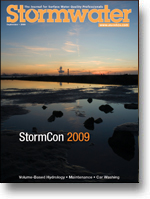Pervious Pavers: Choosing products and installation methods

Permeable pavement is one of four recommended low-impact development (LID) methods promoted in an LID manual being developed by Sarasota County, Florida, and the Southwest Florida Water Management District. Also, Florida’s Department of Environmental Protection is working on a statewide water-quality treatment rule to get everyone on the same page
Permeable pavement can take the form of concrete pavers, plantable and drivable grass products, bricks, and recycled tires, as well as asphalt and poured-in-place concrete.
In an article published in the September 2009 issue of Stormwater Magazine, writer Carol Brzozowski focuses mainly on paver-type products. She draws on a number of sources, including the Interlocking Concrete Pavement Institute, to summarize how to choose which product is most appropriate.
“General questions to consider include installation procedures; what type of base course is needed; and whether the native soil needs to be replaced with another type for better drainage and infiltration. The installation and the soil type can also affect load-bearing capacity, maintenance requirements, and ability to filter pollutants from stormwater runoff. In cold climates, the surface’s ability to be plowed may also be a consideration,” she writes.
Acknowledgment:
 Before STORMWATER, The Journal for Surface Water Quality Professionals, there was no single publication written specifically for the professional involved with surface water quality issues, protection, projects, and programs. To download a copy of the article, click on this link to Permeable Pavers — Part 1: Choosing products and installation methods.
Before STORMWATER, The Journal for Surface Water Quality Professionals, there was no single publication written specifically for the professional involved with surface water quality issues, protection, projects, and programs. To download a copy of the article, click on this link to Permeable Pavers — Part 1: Choosing products and installation methods.
Posted August 2009

